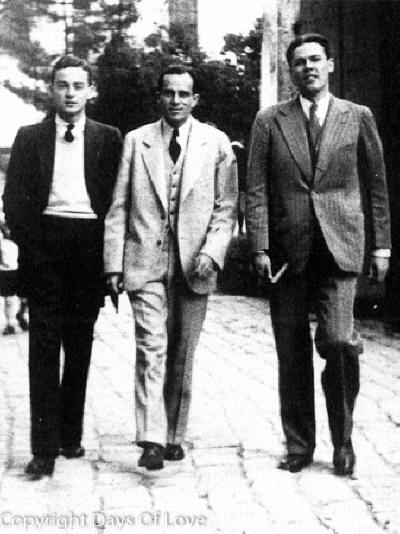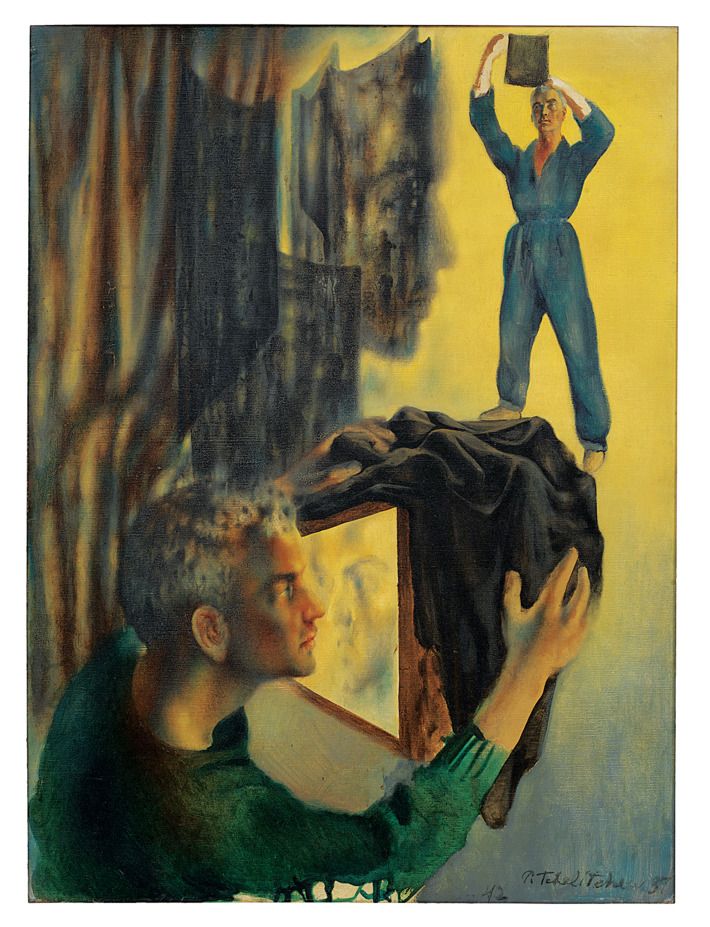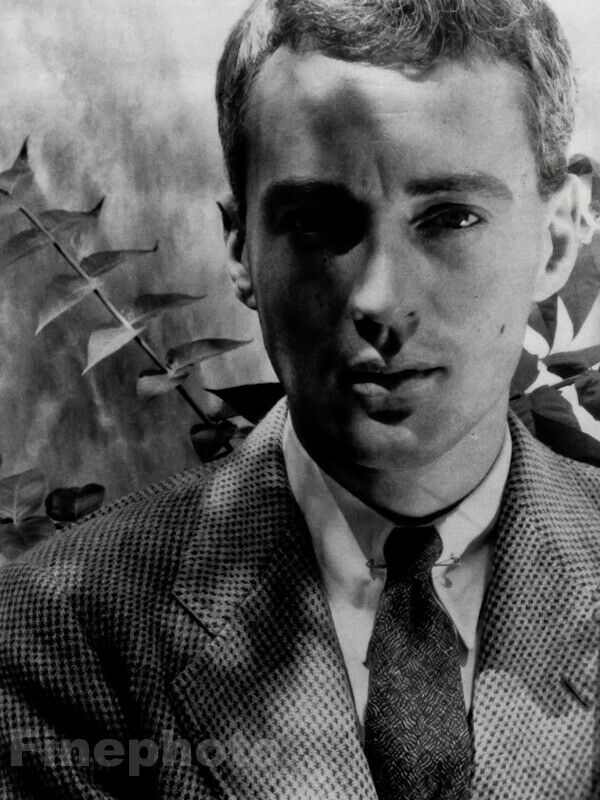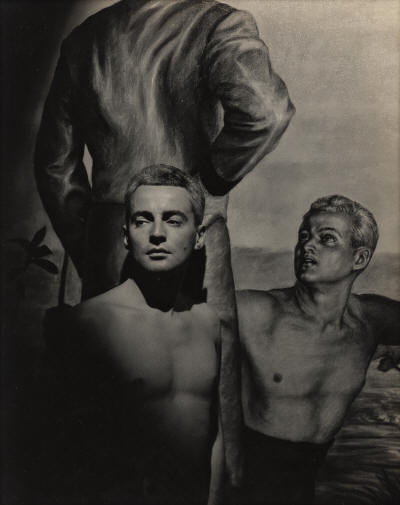

Partner Monroe Wheeler and Glenway Wescott
Queer Places:
Berkshire School, 245 N Undermountain Rd, Sheffield, MA 01257, USA
Yale University (Ivy League), 38 Hillhouse Ave, New Haven, CT 06520
Stone-blossom, Clinton, NJ 08809, Stati Uniti
48 E 89th St, New York, NY 10128
640 Madison Ave, New York, NY 10065
421 Park Ave, New York, NY 10022
Woodlawn Cemetery, E 233rd St & Webster Avenue, Bronx, NY 10470, Stati Uniti
 George Platt Lynes (April 15, 1907 – December 6, 1955) was an
American
fashion and
commercial photographer who worked in the 1930s and 1940s.[1]
He produced some photographs featuring many gay artists and writers from the
1940s that were acquired by the
Kinsey Institute after his death in 1955.[2]
George Platt Lynes (April 15, 1907 – December 6, 1955) was an
American
fashion and
commercial photographer who worked in the 1930s and 1940s.[1]
He produced some photographs featuring many gay artists and writers from the
1940s that were acquired by the
Kinsey Institute after his death in 1955.[2]
Born in East Orange, New Jersey to Adelaide Sparkman and Joseph Russell Lynes (died 1932).[1][3] His younger brother was Joseph Russell Lynes, Jr. (1910–1991). Lynes spent his childhood in New Jersey but attended the Berkshire School in Massachusetts, where he was a classmate of Lincoln Kirstein. He was sent to Paris in 1925 with the idea of better preparing him for college. His life was forever changed by the circle of friends that he would meet there including Gertrude Stein, Glenway Wescott, Monroe Wheeler.
Through Gertrude Stein he met Pavel Tchelitchew, Carl Van Vechten, André Gide and René Crevel. Crevel would be his occasional lover. Back in the United States, he published booklets by Stein and Ernest Hemingway under his own imprint, As Stable Publications.
He attended Yale University in 1926, but dropped out after a year.[4] He had returned to the United States with the idea of a literary career and he even opened a bookstore in Englewood, New Jersey in 1927. He first became interested in photography not with the idea of a career, but to take photographs of his friends and display them in his bookstore.
On his second trip to France, in 1928, he stayed in Villefranche-sur-Mer on the Riviera with Glenway Wescott and Monroe Wheeler. There he met Jean Cocteau, Isadora Duncan and others. That year he posed as Apollo, naked, for a photograph by Man Ray.

George Platt Lynes, by Pavel Tchelitchew
.jpg)
Self-portrait with Chuck Howard

George Platt Lynes & Pavel Tchelitchev

Self-portrait

GEORGE PLATT LYNES (1907-1955)
Self Portrait in front of Jared French's mural "Cavalrymen Crossing a River."
Silver print, the image measuring 241.3x190.5 mm; 9 1/2x7 1/2 inches. Circa 1939.
.jpg)
Yale University, New Haven, CT
Returning to France the next year in the company of Wescott and Wheeler, he traveled around Europe for the next several years, always with his camera at hand. He developed close friendships within a larger circle of artists including Jean Cocteau and Julien Levy, the art dealer and critic. Levy would exhibit his photographs in his gallery in New York City in 1932 and Lynes would open his studio there that same year.
He was soon receiving commissions from Harper's Bazaar, Town & Country, and Vogue[1] including a cover with perhaps the first supermodel, Lisa Fonssagrives. In 1935, he was asked to document the principal dancers and productions of Kirstein's and George Balanchine's newly founded American Ballet company (now the New York City Ballet).[2][5]
He was also most notably friends with Katherine Anne Porter,[5] author of the novel Ship of Fools, whom he often enjoyed photographing wearing elaborate evening gowns and occasionally reenacting Shakespeare.[6]
During his lifetime, Lynes amassed a substantial body of work involving nude and homoerotic photography. In the 1930s, he began taking nudes of friends, performers and models, including a young Yul Brynner, although these remained private, unknown and unpublished for years.[2] Over the following two decades, Lynes continued his work in this area passionately, albeit privately. "The depth and commitment he had in photographing the male nude, from the start of his career to the end, was astonishing. There was absolutely no commercial impulse involved — he couldn't exhibit it, he couldn't publish it." - Allen Ellenzweig, art and photography critic who wrote the introduction to George Platt Lynes: The Male Nudes, published in 2011 by Rizzoli.[7]
In the late 1940s, Lynes became acquainted with Dr. Alfred Kinsey and his Institute in Bloomington, Indiana.[7] Kinsey took an interest in Lynes work, as he was researching homosexuality in America at the time.[2] A large number of Lynes' nude and homoerotic works were left to the Kinsey Institute after his death in 1955.[4] The body of work residing at the Kinsey Institute remained largely unknown until it was made public and published later.[8] The Kinsey collection represents one of the largest single collections of Lynes's work.[7]
For over ten years, Lynes had a love affair with both Monroe Wheeler, the curator, and Glenway Wescott, the writer.[8] He later got together with his studio assistant and, after he died in World War II, Lynes moved in with the younger brother of the assistant.[8]
In August of 1947, Wil Wright, Jr (the owner of the Ice Cream Shoppes) and his lover Randy Jack rented a room in Lynes’ Hollywood home. Lynes was in the midst of his “Hollywood period” working for Vogue magazine. Lynes – who always lived beyond his means and was notoriously bad with money management – decided to take in roommates to share chores and expenses. This arrangement did not last long because, as Lynes wrote to a friend, “Wil can’t bear not to be boss and that is one thing he can’t be. Not here.” Wright also resented George’s influence on Jack, encouraging him to pursue a career as a dancer. When Wil moved out after a couple of months, Randy stayed and found his way into Lynes’ bed as well. Randy Jack committed himself to a vigorous regimen of ballet classes. Although Lynes was aware that Jack was a bit long in the tooth to start training for a career as a dancer, he supported his efforts nonetheless. He wrote to his friend Monroe Wheeler; “He’s too old, 21, but he has a ballet dancers body and a ballet dancer’s soul.” Randy Jack’s protruding ears – called “bat like” in several accounts – were viewed by Lynes as a further hindrance to attaining success as a ballet dancer. While he could not erase Jack’s advanced age, he could do something to remove this obstacle, so the cards would be “stacked in his favour, to remove whatever flies there may be in the ointment.” He agreed to barter with a plastic surgeon: Lynes would photograph the surgeon’s glamorous wife in exchange for the operation to pin back Jack’s ears. Lynes wrote to his mother at the time: “…I can’t leave things alone but redecorate or remodel anything I can lay my hands on, people as well as houses.”
The photos of Randy Jack taken in Lynes’ library are understandably the most popular. Ears firmly clipped, Lynes photographed his roomie en tenue de danse at Vogue studios, creating a striking series of photos. In May of 1948, Lynes’ contract with Vogue ended and he returned to New York City with Randy and their dog Bozo in tow. Randy Jack was the subject of several other artists’ work, including Bernard Perlin. Soon after their move to New York, Jack abandoned his ballet studies and began to find work as a fashion model. This proved to be a far more attainable and lucrative goal. In mid-summer, George wrote to Katherine Anne Porter that he was troubled about the young man, “I wonder what New York has done to him, or what I have done.”
Randy moved out in the Fall of 1948 and Lynes’ next boyfriend and muse, Chuck Howard moved into the apartment 10 days later. Platt-Lynes now found himself with plenty of work and plenty of people to see. His old coterie of Monroe Wheeler, Glenway Wescott, Paul Cadmus, Jared and Margaret French, and Lincoln and Fidelma Kirstein welcomed Chuck Howard, in part because he had a beneficial and organizing influence upon the photographer. “Another twenty-one-year-old has moved in on me bag and baggage, almost without being invited..” Lynes wrote in a letter to his friend, author Katherine Anne Porter.
In 1951, George Platt-Lynes’s financial situation worsened, as did his personal life. Although he had clients that were loyal to him, such as the stores Sacks Fifth Avenue and Bendel’s, his income was not enough to sustain his accustomed lifestyle: the lavish entertaining, the gifts of jewelry to favorites, the keeping up with his society friends. At the same time his relationship with Chuck Howard ended, which removed Chuck’s steadying effect on his life. In January 1951, his letter to his mother reported, “Late last week, Chuck decided to go off and live by himself. It’s a pity, for I shall miss him; but I don’t disapprove… I’m afraid that my influence is too often all-pervading, all-inclusive.”
By May 1955, Lynes had been diagnosed terminally ill with lung cancer. He closed his studio and was reported to have destroyed much of his print and negative archives, particularly his male nudes. However, it is now known that he had transferred many of these works to the Kinsey Institute. "He clearly was concerned that this work, which he considered his greatest achievement as a photographer, should not be dispersed or destroyed...We have to remember the time period we're talking about—America during the post-war Red Scare..."[7]
After a final trip to Europe, Lynes returned to New York City, where he died in 1955, while living with his brother and his family.[1]
My published books: